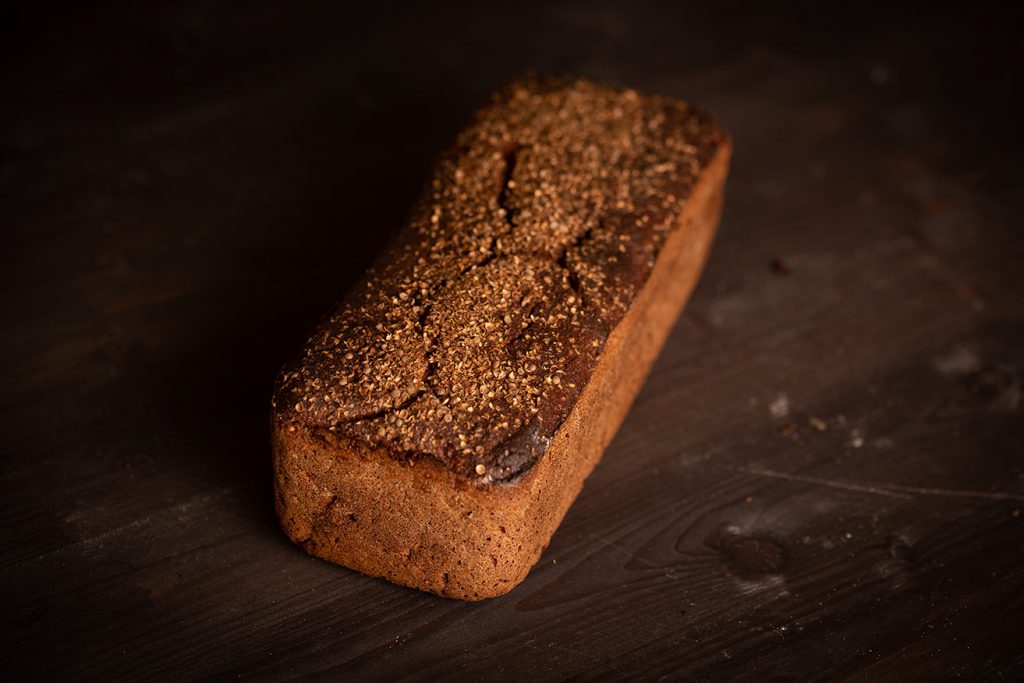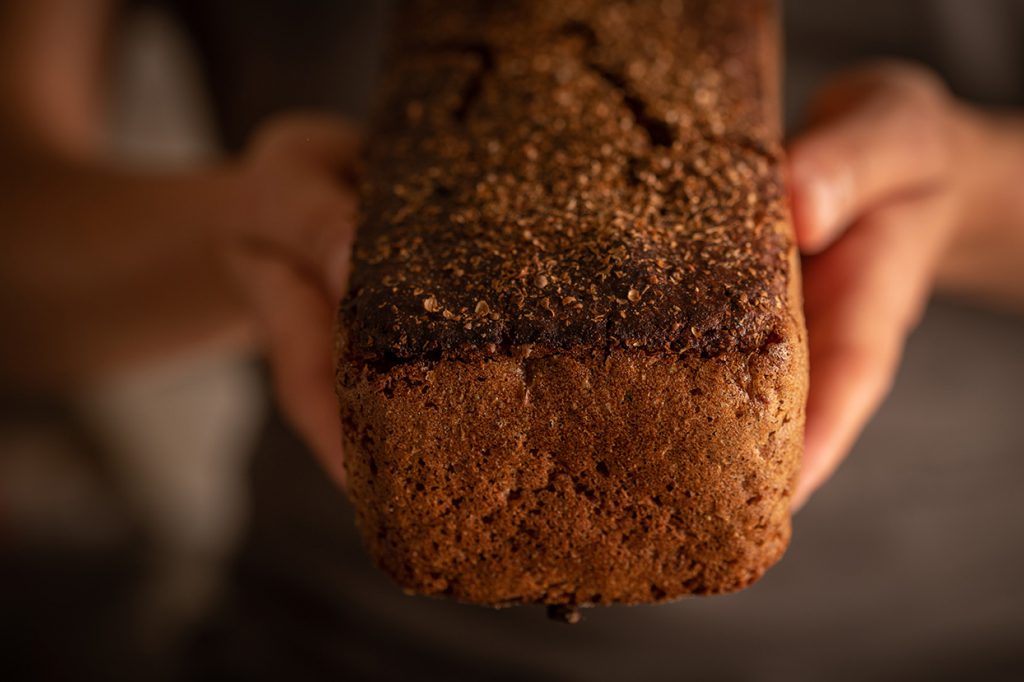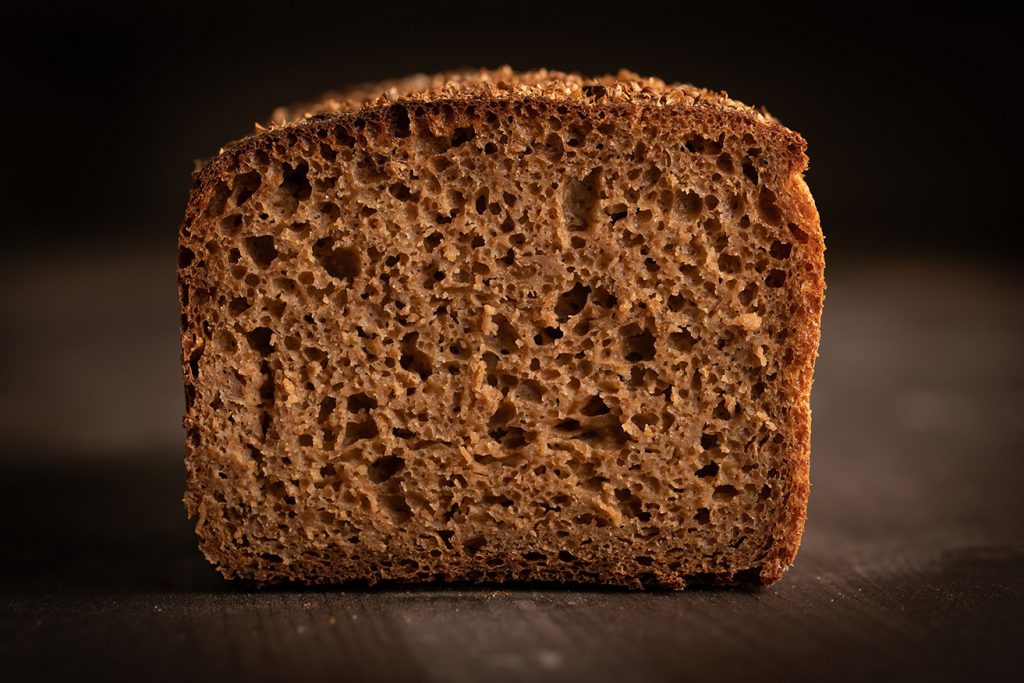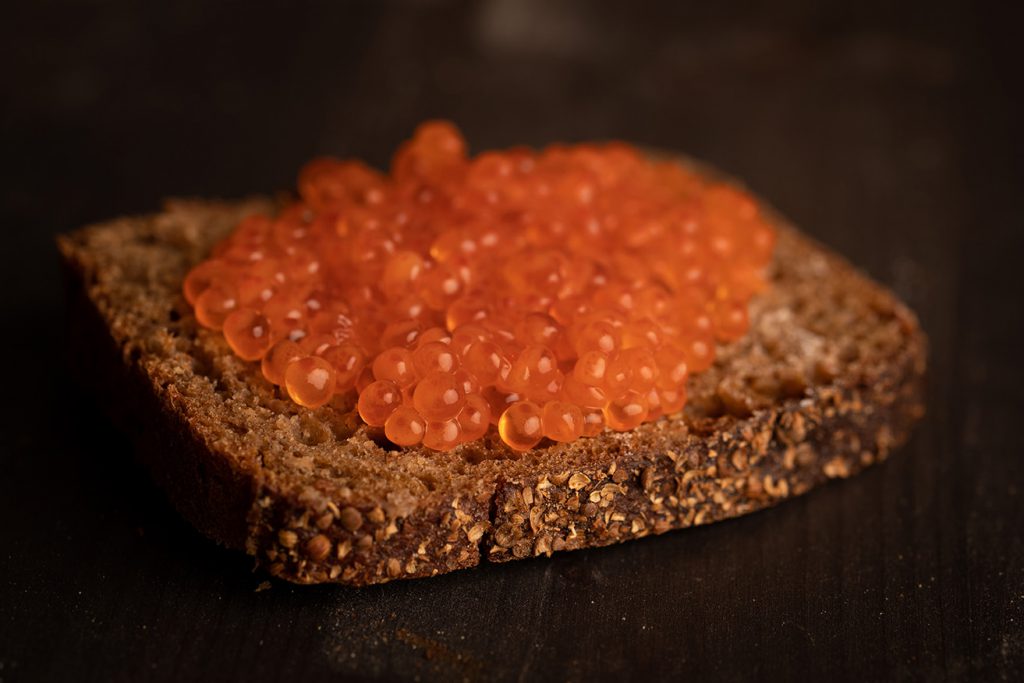Main features: dense, brick-like bread
Type of dough: rye, sticky dough
Flours used: rye flour, red rye malt, wheat flourTips for a correct execution:
Tips for a correct execution:
- proofing times can be very short, keep your eyes on the dough at all times;
- Rest the bread for at least 24 hours (ideally 48 hours) after baking before cutting;
- Working with this type of dough can be very difficult, having wet hands and utensils helps.
Pairing: works best in association with fish, caviar, cured meats.
From Russia. The one and only, Borodinsky. There are many legends about how the Borodinsky bread came to be. The most popular one states that this bread traces its name to Margarita Tuchkova, a widow of a napoleonic wars general, who perished in the Borodino battle. His widow established a convent and had to come up with a bread to serve at mourning events, thus, a dark, solemn color, and with round coriander seeds representing a deadly grapeshot.
Another legend that also ties it to the Battle of Borodino mentions a food trailer containing coriander and rye flour that got blasted by a cannon, forcing the locals to recover the ingredients and use them together for the first time.
We don’t know how it came to be, but we do know it’s probably one of the most remarkable rye breads in the world, a spectacular sweet mix of fermented rye, red malt (which we made ourselves, since it was impossible to source in Romania) and coriander seeds. It works perfectly with fish or cured meats, but also just with plain butter for breakfast.

So how is it made?
As you’re about to find out, both the ingredients list and the steps you need to follow are a bit more complictated than with other breads.
Time T0 (e.g, the evening before you prepare the final dough)
Step 1 – prepare your Starter
Rye flour – 120 grams
Warm water (no warmer than 40 Celsius) – 200 grams
Rye starter (fed with only rye at least 3-4 times) – 60 grams
Mix your ingredients and leave it in a warm spot for 12 hours.
Step 2 (the same time you prepare the Starter T0) – prepare the Scald.
Cracked rye berries – 60 grams
Red rye malt – 20 grams
Boiling water – 150 grams
Ground coriander seeds – 2 grams
(Insert photo Borodinski 2)
Leave your scald in a warm spot for 12 hours.

A few words about some ingredients you may be a bit unfamiliar with:
- Cracked rye – you can crack rye berries in a mill or, if you don’t have one, you can also use a coffee or spice grinder to crack them. You only need to crack the berries, not grind them to a fine flour, the idea here is that if your berries are whole, they might not hydrate properly in your dough. However, if they are too fine, they will have a different texture to cracked berries. If you don’t have any option to purchase and grind rye berries, you can also use wholemeal rye flour.
- Red rye malt is an ingredient that we recommend you don’t skip in your recipe, as malt imoarts a certain sweetness to your dough. You may be a bit unfamiliar with malt, so what is malt anyways? Malt or malted cereal berries are basically cereal grains that undergo a series of enzymatic and thermal transformations as follows:
- First cereal grains are soaked in water and left to sprout
- Once sprouted, enzymes in the grains start to transform starches into simple sugars, which imparts a certain sweetness to the grain
- The process is then arrested by baking the grains. Depending on the temperature they are baked the malt ranges from a very light to a very dark color.
So how can you get your hands on red rye malt then?
- If you live in Russia or baltic countries, chances are you can find it ready made in specialty stores (such as breweries or even baker’s shops)
- If you don’t (we also cannot source it in Romania) you can make your own red malt by baking light rye malt (which you can find in artisan brewer’s shops) at 170 C for about 15 minutes. You will see the malt change color to a reddish hue and the taste will also change, imparting notes of caramel and coffee to your dough.
- Or, of course, you can make your own rye malt from rye berries, but that is a bit of an overkill.
- Step 3 – 12 hours after preparing the starter and scald, mix them together and leave them in a warm spot for about 3 hours, until it doubles its volume.
- Step 4 – After 3 hours , prepare the final dough by mixing together the following ingredients:
- Scald – Starter mix (all of it, approximately 600 grams)
- Wholemeal rye flour – 110 grams
- White bread flour – 70 grams
- Salt – 5 grams
- Dark molasses – 15 grams (it will impart color and sweetness to your dough)
- Red rye malt – 5 grams
Mix the ingredients until fully incorporated and until you get a muddy gelatinous mass. Yes, it’s perfectly normal that your dough looks like a bunch of mud, it’s not a bug, it’s a feature. 😊

- Step 5 – Ferment your dough for an hour, then transfer it to a well greased loaf pan.
- Step 6 – leave your dough to ferment in the pan for another 90 minutes.
- Step 7 – Preheat your oven to 250 degrees Celsius (or 280, if your oven can reach more than 250 C) and prepare your steam source (volcanic rock or a ceramic dish filled with water on the bottom of your oven).
- Step 8 –using a wet brush, brush your loaf and sprinkle coriander seeds on top of it.
- Step 9 – when fully fermented (after approximately 90 minutes) place your pan in the oven and bake with steam for 10 minutes.
- Step 10 – remove the steam source and lower the temperature to about 170 degrees and bake for another 60 minutes or until the core temperature reaches 92 C.
- Step 11 – remove the loaf from the oven, leave it to cool down, wrap it in a towel and leave it to rest for a minimum of 24 hours before you slice it.
Borodinsky is a very special bread, that pairs wonderfully with cured meats, fish, fish roe, but you can also simply butter it up and have it for breakfast.
The recipe is a bit more complicated, we reckon, but the taste and texture of this loaf are well worth the effort. It one of the truly remarkable recipes the world has given us and that is why we advise you to be patient, to source the proper ingredients and follow the process to get the best results.
Nasdrovia!

